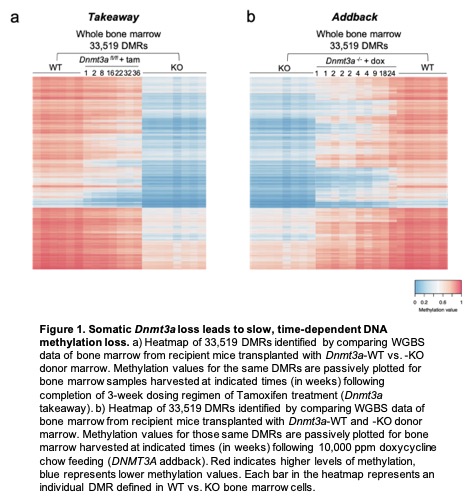Abstract
Introduction
Somatic mutations in the gene encoding DNA methyltransferase 3A (DNMT3A) are the most common cause of clonal hematopoiesis, and among the most common initiating events for acute myeloid leukemia (AML). Constitutional DNMT3A mutations cause DNMT3A Overgrowth Syndrome, associated with obesity, overgrowth, behavioral problems, and increased risk of hematopoietic malignancies after years of latency [1]. Studies of germline and somatic Dnmt3a knockout mice have identified focal, canonical hypomethylation phenotypes in hematopoietic cells. This hypomethylation phenotype is thought to contribute to the epigenetic "fitness" of hematopoietic cells to acquire cooperating mutations that cause clonal progression and AML. However, the kinetics of methylation loss following mutational inactivation of DNMT3A in hematopoietic cells is essentially unknown.
Methods
Bone marrow from C57Bl/6-CD45.2 Dnmt3a fl/fl -ERT2-cre mice was transplanted into lethally irradiated C57Bl/6-CD45.1 recipients. Engraftment frequencies of >80% were detected in virtually all mice. Inactivation of Dnmt3a was induced with 9 doses of Tamoxifen (tam) given by gavage on MWF for three consecutive weeks. Bone marrow samples were serially collected for whole-genome bisulfite sequencing (WGBS) and analysis as previously described [1-4]. We compared these data to WGBS data from previously published doxycycline inducible DNMT3A transgene addback data, described in [3].
Results
Cre-mediated deletion of exon 19 (flanked by loxP sites) leads to out-of-frame splicing of the mRNAs encoding all active isoforms of Dnmt3a. To limit Dnmt3a inactivation to hematopoietic cells, we used a transplantation model, which allowed us to eliminate the effects Dnmt3a loss in non-hematopoietic tissues. Floxing efficiency in the bone marrow was >90% 1 week after the last dose of Tam, and these levels persisted until the last mice in the cohort were analyzed 35 weeks later. We defined differentially methylated regions (DMRs) using WGBS data derived from WT vs Dnmt3a knockout (KO) bone marrow samples, using previously described criteria [4]. We identified 33,519 focal, highly canonical DMRs in the KO samples; 33,504 (99.96%) of these were hypomethylated, compared to WT marrow. Passively plotting the methylation values of the Dnmt3afl/fl + tam ("takeaway") samples for these DMRs over time (Figure 1a) revealed a slow, progressive, ordered loss of methylation, although the degree of methylation loss did not reach KO levels by 36 weeks. In contrast, remethylation of most of these DMRs with transgene-driven DNMT3A "addback" in KOmice revealed methylation 'correction' that started rapidly (within 1-2 weeks), and that approached wild-type levels by 24 weeks (Figure 1b). Combined, these data show that methylation loss after Dnmt3a inactivation occurs much more slowly than remethylation of Dnmt3a-dependent sites following restoration of DNMT3A activity. This trend was true across all functionally annotated regions of the genome, including gene bodies, promoters, enhancers, transcriptional start sites (TSS) and CpG islands. Importantly, DMRs that lost methylation rapidly in the takeaway setting, also gained methylation rapidly with addback, suggesting that there is a canonical set of genomic regions where DNA methylation is actively "remodeled". These "Dynamic DMRs" are significantly smaller (and had fewer CpGs) than DMRs associated with slower rates of remodeling.
Conclusions
These data describe a very slow rate of methylation loss following Dnmt3a inactivation in hematopoietic cells. We also describe regions of the genome (Dynamic DMRs) where DNA methylation is actively remodeled in hematopoietic cells, presumably by the collaborative action of de novo DNA methylases (Dnmt3a and Dnmt3b) vs. the DNA demethylases (i.e. the TET family of enzymes). Since clonal hematopoiesis patients with DNMT3A mutations can have very long latent periods before developing hematopoietic malignancies, these data suggest that long latency may be (at least in part) related to the very slow loss of DNA methylation at relevant regions of the genome after a DNMT3A allele acquires an inactivating somatic mutation.
Leight: Amgen: Current Employment.


This feature is available to Subscribers Only
Sign In or Create an Account Close Modal